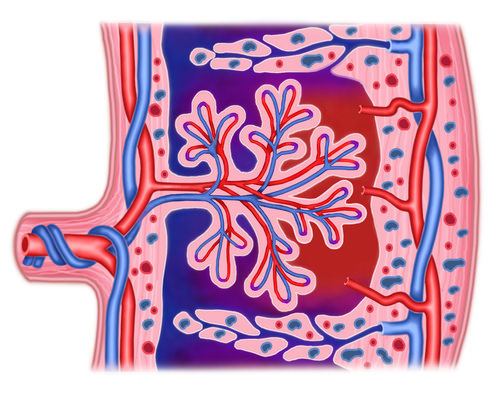13.64: The Placenta
- Page ID
- 13535

How does a developing baby breathe?
Or eat? From mom, of course. Shown is a detailed representation of the placenta. And this is where all these interactions occur.
Placenta and Related Structures
The fetus could not grow and develop without oxygen and nutrients from the mother. Wastes from the fetus must also be removed in order for it to survive. The exchange of these substances between the mother and fetus occurs through the placenta.
Placenta
The placenta is a temporary organ that begins to form from the trophoblast layer of cells shortly after implantation. The placenta continues to develop and grow to meet the needs of the growing fetus. A fully developed placenta is made up of a large mass of blood vessels from both the mother and fetus. The maternal and fetal vessels are close together but separated by tiny spaces. This allows the mother’s and fetus’s blood to exchange substances across their capillary walls without the blood actually mixing.
The fetus is connected to the placenta through the umbilical cord, a tube that contains two arteries and a vein. Blood from the fetus enters the placenta through the umbilical arteries, exchanges gases and other substances with the mother’s blood, and travels back to the fetus through the umbilical vein.
 The fetus and the placenta. Notice the fetus is attached to the placenta by the umbilical cord, made of two arteries and one vein.
The fetus and the placenta. Notice the fetus is attached to the placenta by the umbilical cord, made of two arteries and one vein.Amniotic Sac and Fluid
Attached to the placenta is the amniotic sac, an enclosed membrane that surrounds and protects the fetus. It contains amniotic fluid, which consists of water and dissolved substances. The fluid allows the fetus to move freely until it grows to fill most of the available space. The fluid also cushions the fetus and helps protect it from injury.
Summary
- The placenta allows nutrients and wastes to be exchanged between the mother and fetus.
- The fetus is connected to the placenta through the umbilical cord.
Review
- What makes up a placenta?
- Describe the role of the placenta in fetal development.
- What is the umbilical cord? What occurs in the umbilical cord?
| Image | Reference | Attributions |
 |
[Figure 1] | Credit: Image copyright EmeCeDesigns, 2014 Source: http://www.shutterstock.com License: CC BY-NC |
 |
[Figure 2] | Credit: Image copyright EmeCeDesigns, 2014 Source: http://www.shutterstock.com License: Used under license from Shutterstock.com |

